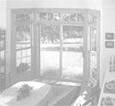Tips for an Energy Efficient Home Remodel
If you are rebuilding your home and want to incorporate energy-saving
features, look for the following information on products and packages:
- For home insulation, look for the R-value. The higher the R-value,
the better the insulating power. - For major appliances, look for the bright yellow Energy Guides.
These will help you shop for the most energy-efficient models. - For window products, look for the U-value. The lower the U-value,
the more energy efficient the product is. - For light bulbs, look for light output. To save energy costs, find the bulbs
with the light output you need, then choose the one with the lowest watts.
If you are rebuilding your home, you may want to incorporate energy-saving features. These could include insulation and energy-efficient appliances, windows, doors, and light bulbs.
Energy-efficient features can save you money over time. That's because you pay less for energy costs year after year.
The Federal Trade Commission (FTC) requires many products to include energy information. You'll find this information right on the product or package. This brochure will explain what to look for to make the best energy and money-saving choices.
 Home Insulation: Look for the R-Value
Home Insulation: Look for the R-Value
Insulating your home can dramatically cut down on home
heating and cooling costs.
When you shop for insulation, always look for the "R-value."
The higher the R-value, the better the insulating power.
R-value measures insulating power. Thicker insulation does not necessarily mean higher R-value.
To find the R-value you need, check with your local utility company. Recommended levels vary depending on where you live. Remember: if you install more insulation than necessary, youll waste money. If home contractors install your insulation, be sure to discuss what R-value is best for your home.
Ask retailers and home installers for a fact sheet on insulation before buying. This fact sheet, required by the Federal Trade Commission (FTC), tells you the type of insulation, its R-value, and the area it will cover.
If home contractors install your insulation, they must give you a contract or receipt showing the insulations R-value, coverage area, and thickness. If loose-fill insulation is installed, the number of bags used also must be included.
Energy-Efficient Appliances: Look for the Yellow Energy Guides
If you want to buy energy-efficient major appliances, look for the bright yellow "Energy Guide" labels on each model. These labels can help you select an appliance that uses less energy and costs less to run than other similar models.
The Energy Guide sticker appears on refrigerators, refrigerator-freezers, freezers, dishwashers, clothes washers, water heaters, furnaces, heat pumps, and air conditioners.
The Energy Guides help you select energy-efficient models. Some Energy Guides show you how much energy a particular appliance uses compared with models of a similar size. The model using less energy will cost you less to operate. Other Energy Guides measure energy efficiency compared with similarly-sized models. The most energy-efficient model will cost less to operate.
Many of the Energy Guides also show the estimated yearly operating cost of a particular appliance. You can compare this figure with similar models to find one that costs less to use.
Windows: Look for the U-Value
You may want to rebuild your home with energy-saving window products. These include all types of windows, doors with windows, and skylights.
To find the most energy-efficient window product, look for the U-value. The lower the U-value, the more energy-efficient the product is.
U-value measures how well heat is conducted through a window. For assurance that the U-value is calculated correctly, look for an "NFRC" label. This represents the National Fenestration Rating Council, which is the industry group that sets standards for U-value measurements.
If home contractors install your windows, be sure to discuss what U-value is best for your home.
Lamps and Light Bulbs: Look for the Light Output
You can save money over the long run by buying energy-efficient light bulbs. But shop for "light output," not watts.
Light output (lumens) is basically the amount of light a bulb produces. Watts measure the amount of energy used.
You may be used to buying light bulbs by looking for watts (e.g., "75" or "100" watts). But different watt bulbs can produce the same amount of light. If you buy a lower watt bulb that provides the same amount of light, you'll save money in energy costs.
There are several different kinds of bulbs. These include:
- Incandescent. These are the standard light bulbs. To save energy costs, find the bulbs with the light output you need, then choose the one with the lowest watts.
- Compact fluorescent. Often recommended by utility companies, compact fluorescents can last more than 10 times longer than incandescent bulbs. Though more expensive to buy, compact fluorescents are cheaper to use over the long run than incandescent bulbs. Over the life of the bulb, the lower operating cost offsets the higher initial purchase price. Some utility companies offer money-saving coupons or rebates for these products.
The type of light produced by incandescent and compact fluorescent bulbs differs. You may want to experiment with each to see which works best for you.
- Incandescent reflector (flood and spotlights). Select the most energy-efficient flood lamps or spotlights by finding the bulbs with the light output you need, then choose the one with the lowest watts.
When rebuilding or remodeling, remember that some energy-efficient light bulbs (such as compact fluorescent or halogen bulbs) come in different sizes and shapes. In addition, compact fluorescent bulbs cannot be used under all circumstances -- for example, they are inappropriate for use in fixtures with dimmers. Therefore, you may need to buy ceiling fixtures or table or floor lamps that are designed specifically to accommodate them.